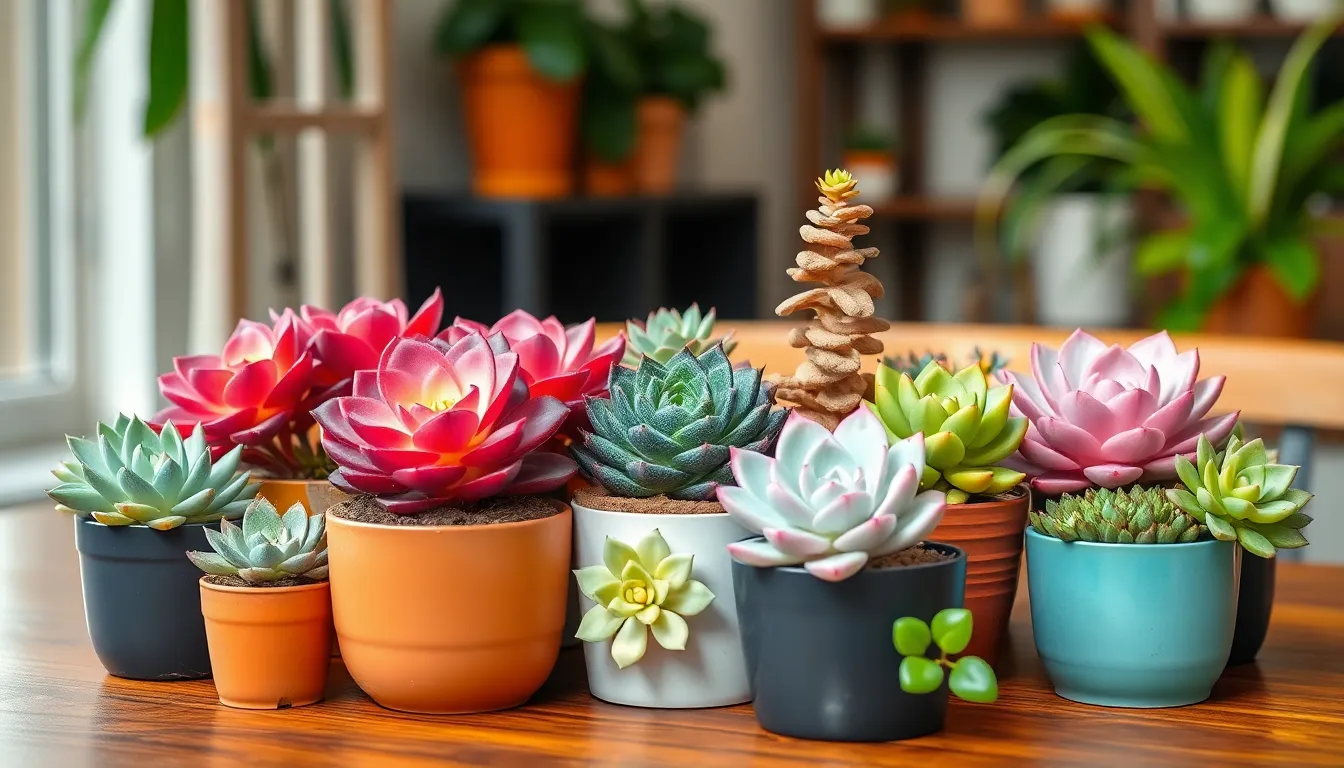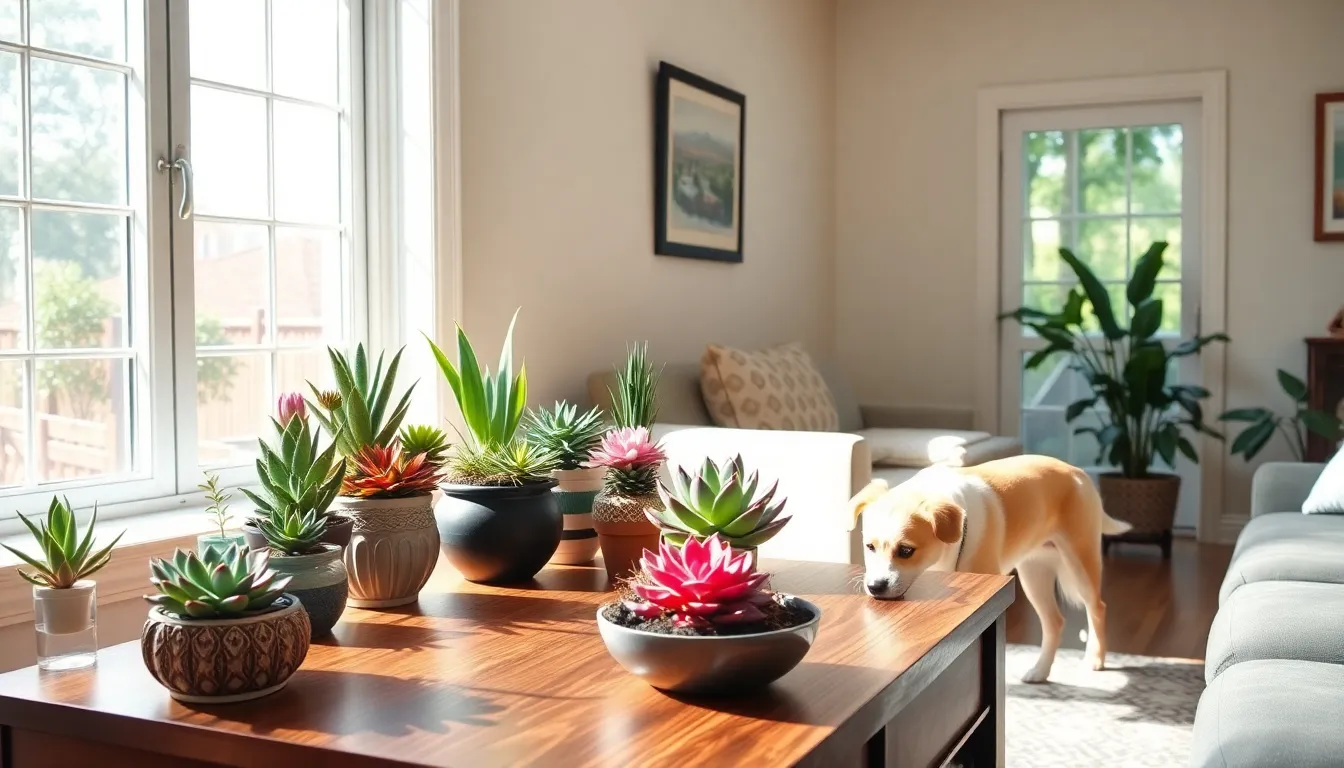Bringing a touch of greenery into a home is a great way to elevate the vibe, but what if you’ve got a furry friend who thinks every plant is a chew toy? Fear not! Pet-safe succulents are here to save the day—and your plants. These low-maintenance beauties not only add a splash of color but also ensure your curious companions stay safe while exploring their indoor jungle.
Pet Safe Succulents
Pet safe succulents provide an excellent option for pet owners who want to decorate their homes without harming their furry friends. These resilient plants thrive indoors and outdoors while ensuring safety amidst curious pets.
Importance of Choosing Pet Safe Plants
Choosing pet safe plants protects pets from potential harm. Many common houseplants contain toxins that can lead to serious health issues if ingested. Pet owners must prioritize their pets’ well-being by selecting plants recognized as non-toxic. Moreover, pet safe succulents, such as Echeveria and Haworthia, add beauty to any space without the risk of poisoning. Fostering a safe environment encourages pet exploration without apprehension or worry.
Common Myths About Succulents and Pets
Many misconceptions surround the idea of succulents being unsafe for pets. Some believe that all succulents pose a risk to animals, yet this isn’t accurate. In fact, numerous succulent species are harmless if pets attempt to chew on them. For instance, jade plants and aloe vera aren’t pet safe, while species like jade and Sempervivum are completely safe. Owners often overlook this crucial distinction, leading to unnecessary fear about plant selection. Education about specific plant types empowers pet owners to choose safe options confidently.
Popular Pet Safe Succulents

Many pet owners enjoy incorporating succulents into their homes. These plants not only add beauty but also keep pets safe from toxins.
Aloe Vera
Aloe Vera is commonly known for its healing properties. While the gel inside the leaves benefits humans, the plant itself poses a risk to pets. Fortunately, the Aloe Vera species that is typically kept as a houseplant can be unsafe. It’s essential to choose Aloe varieties that are explicitly labeled as non-toxic to ensure a safe environment for pets.
Haworthia
Haworthia is an excellent choice for pet-friendly homes. This succulent thrives in low light and requires minimal water. With various attractive shapes and sizes, it fits well in different decor styles. Haworthia offers a unique look without the risk of toxicity, making it a favorite among pet owners seeking safe plants.
Echeveria
Echeveria showcases stunning rosettes and vibrant colors. These succulents are not only visually appealing, but they also pose no threat to pets. Echeveria varieties are adaptable and thrive in a range of conditions. Owners appreciate their low maintenance and safe status, making them ideal additions to a pet-friendly space.
Benefits of Having Succulents at Home
Succulents offer numerous advantages for households, especially for pet owners. Their unique characteristics contribute to both aesthetic appeal and practical benefits.
Low Maintenance
Succulents thrive with minimal care, making them ideal for busy individuals. These plants require infrequent watering, often every two to three weeks, depending on the environment. Many varieties tolerate drought, flourishing without constant attention. They adapt well to various lighting conditions, from indirect sunlight to low light. Choosing succulents means fewer worries about plant care, allowing pet owners to focus on their furry companions.
Air Purification
Air quality improves with the presence of succulents in the home. Certain succulents help filter pollutants and toxins from the air, contributing to a healthier environment. Studies show plants such as Aloe Vera and Echeveria can reduce indoor air toxins. Increased oxygen levels result from photosynthesis, promoting overall well-being. These plants offer not only visual appeal but also enhance air quality, benefiting both pets and their owners.
Tips for Caring for Pet Safe Succulents
Caring for pet-safe succulents involves attention to light and water. These plants thrive in conditions that mimic their native environments, ensuring healthy growth.
Light Requirements
Succulents generally prefer bright, indirect sunlight. Many species, including Echeveria and Haworthia, perform well in partial shade. Too much direct sun can lead to leaf burn, while too little light may cause etiolation, where the plants stretch towards the light. Placing succulents near a window with filtered sunlight works best. A south or west-facing window often provides ideal lighting conditions. Periodically rotate the pots to promote even growth, ensuring all sides receive adequate light.
Watering Guidelines
Watering pet-safe succulents requires a careful approach. Generally, wait until the soil dries completely before watering again. A typical schedule involves watering every 2 to 4 weeks, depending on temperature and humidity levels. Overwatering leads to root rot, a common issue among succulents. When watering, apply water directly to the soil, avoiding the leaves to prevent fungal issues. Use pots with drainage holes to allow excess water to escape, promoting healthy root systems.
Conclusion
Choosing pet-safe succulents allows pet owners to enjoy the beauty of plants without compromising their furry friends’ safety. With options like Echeveria and Haworthia, individuals can create vibrant indoor spaces that are both stylish and secure. These low-maintenance plants not only enhance decor but also improve air quality, contributing to a healthier environment for pets and their owners alike. By selecting the right succulents and following simple care tips, pet owners can cultivate a thriving green oasis that is safe for all family members. Embracing pet-safe succulents is a smart choice for anyone looking to harmonize their love for plants with their commitment to pet safety.

